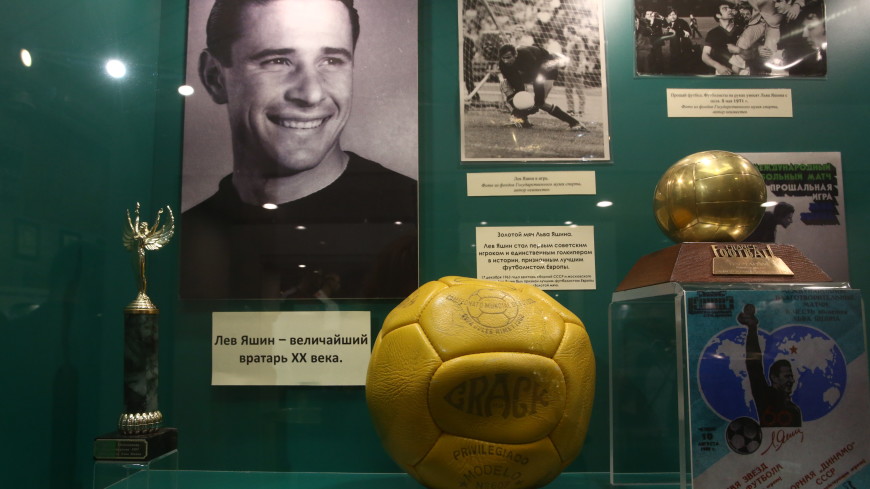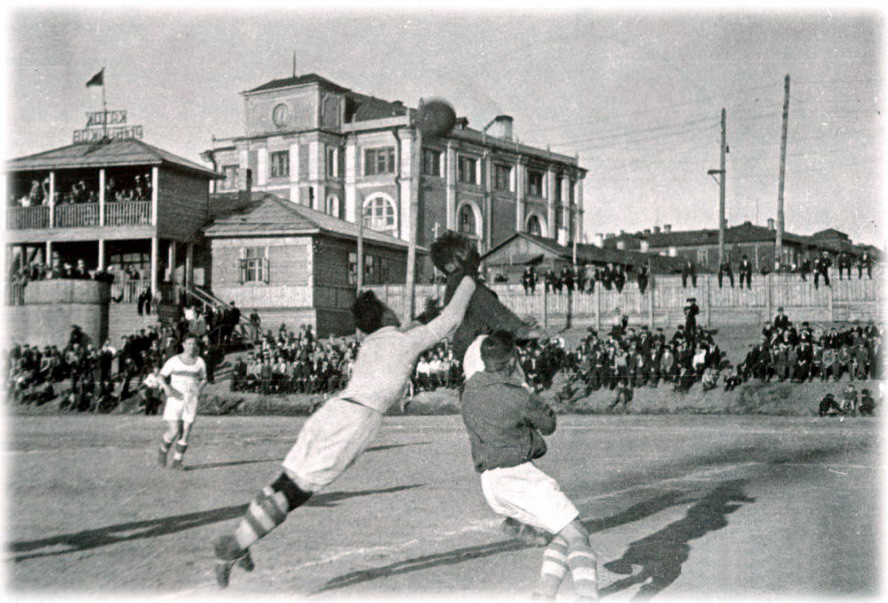For the first time in Russia they played football at the end of the 19th century.
How football appeared in Russia

Football was first played in Russia at the end of the 19th century. English sailors who came to St. Petersburg taught the locals. Here, on Vasilyevsky Island, the first official match took place. On October 24, 1897, the Circle of Sports Lovers played against the Vasileostrovsky Society of Football Players. Score 0-6. Petersburg Leaf wrote about that event with sarcasm:
“Gentlemen athletes in white suits, running through the mud, now and then plopped down into the mud with all their might and soon turned into chimney sweeps. All the time there was incessant laughter in the audience.
First football equipment
Back in 1863 in England they came up with a single uniform for football players. It was called: plus four – long socks, wide trousers, a thick cotton shirt and, of course, a hat. At the beginning of the 20th century, the set was changed. Instead of a shirt – a sweater, trousers were cut off to shorts that were held on by a belt – the elastic band had not yet been invented. In those puritanical times, football shorts had to cover the knees.
First viewers
It was possible to distinguish a football fan from an ordinary city dweller only by his boots – they were always covered in mud. The city was made of stone, it was impossible to get dirty, but football had to be watched on the field. Then even these people were called not fans, but simply spectators.
Game before the revolution
At the beginning of the twentieth century, city football leagues began to appear: first in St. Petersburg, then in Moscow, Odessa, Nikolaev, Riga … In 1912 they merged into the All-Russian Football Union.
Game after the revolution
The revolution of 1917 did not interfere with the development of English fun called football. And even vice versa. Unlike most bourgeois sports, foot football was a priority for the young Soviet state. The first national championship was held in 1923.
First teams and national team
In 1924 the USSR national football team was formed. The Cup of the country was played regularly. Muscovites were trendsetters: Dynamo and Spartak. But teams from other cities also pulled up. In Leningrad – Zenith and also Dynamo, in Kyiv – Dynamo, in Baku there was a Neftyanik, in Tashkent Pakhtakor and so on in almost every republican center.
 Photo: public domain
Photo: public domain
The cult of football in the USSR
Tens of thousands of people attended the matches. These were both ordinary workers from factories, and well-known people throughout the country. For example, the famous composer Dmitry Shostakovich. He supported the Leningrad Dynamo.
“I dearly fell in love with this spectacle and have not missed a single match for five years now” – said the great composer.
Dmitri Shostakovich did not just watch the matches, but kept statistics. Somehow, the neighbors in the stands were arguing about the score of a game that took place several years ago. Shostakovich took out a book already battered by time, leafed through it and confidently named the result.
The first successes of the team
The first successes of the USSR in football on the international arena also occur in the middle of the twentieth century. The most famous are the victory in 1954 over the very strong Swedes 7-0, over the reigning world champions the Germans 3-2. And in 1956 – Olympic gold in Melbourne. In 1960, the USSR national team for the first time in history became the strongest in Europe.
Fans in the mid-twentieth century – although emotional – shout, whistle, tell where to pass and how to hit, but still not organized.
The rise of the fan movement
The first fans in the USSR appeared in Moscow. In the 1970s, the local Spartak often played in European competitions, and fans from England, Holland, Germany, Italy came to visit …
“The guys saw that they could chant together, sing together, wrap themselves in paraphernalia. The guys got an example of fan unity, – says commentator Fedor Pogorelov. “Then the guys came to Leningrad, to the Kirov stadium to play with Zenit, and then the local guys understood how they could, and went and bought the same blue and white panama hats in stores”
But the history of the fan movement begins with the first outing.
“The guys agreed that they would meet at such and such a ticket office, at the Moscow railway station and went to Moscow to play with Spartak. Accordingly, this date in September 1980 is considered the founding day of the Leningrad fan movement. There were 14 of them there at the time.” – says commentator Fedor Pogorelov.
Then the fans began to develop: first, the grandmothers knitted blue-white-blue scarves for them, then pyrotechnics appeared in the stands, they began to draw huge banners for the entire stand. Now it is an art.
Modern fans
Modern football fans can be divided into several categories. The first is the fans.
“The idea of fanaticism in our country appeared just in order to support your team on the road,” says commentator Fedor Pogorelov. “Fans, relatively speaking, are divided into ultras and hooligans.”
Ultras are calm fans. They draw posters, remove the stickers of the opposing team from the stadium, invent and sing chants.
Hooligans, on the other hand, prefer to find out which club is stronger by force.
“They are gathering somewhere in the forest with those who support the other team, and are ready to sort things out with the help of physical force,” – says commentator Fedor Pogorelov.
Becoming a fan is not easy. You can’t just come to the fan sector of the stadium and “become your own”. They just don't let you in there.
“You have to go through an initiation, an interview rite, you have to prove that you had trips not only to Vladivostok, where it was fun for everyone to go, and not to Manchester and Monaco, where there were 10 times more outsiders. There should be a departure to the conditional Yaroslavl, or a “meeting” with the non-Zhegorod riot police. You must show that you are true. To Grozny, for example, or to Makhachkala, – says commentator Fedor Pogorelov.
18-year-old Roman Tubyansky is a fan of the Tosno club from the Leningrad region.He really wanted to get to the main match of his team – the battle for the title, but there was very little money. Then Roma decided to hitchhike and hitchhike. In total, on the way to Volgograd, he spent 3,200 rubles. I ate once a day, spent the night in tents … Once I woke up from the fact that she was surrounded by stray dogs.
“It was scary, I had a hunting knife with me, it calmed me a little. I called my best friend, he motivated me a little, I yelled at the dogs, dispersed them and everything seemed to be fine., – Roman says.
From each city, Roman made sure to take a photo for his mother. She was very worried about her son.
The second category of fans is Kuzmichi. They usually occupy the central sectors of the stadium.
“These are famous people who give advice to the coach and players, who know everything for everyone, mistakenly believing that they are superbly versed in the subject,” – explains commentator Fedor Pogorelov.
The third category of fans is called foam by real fans. These are the people who come to win and see the stadium. There are usually many of them, especially given the boom in stadium construction in Russia for the 2018 FIFA World Cup.
Team nicknames
Every football team has a nickname. Usually it arises due to the origin of the command. For example, FC Lokomotiv means “railroad workers”. But not always everything is so simple. Moscow Spartak is called meat – because once the team belonged to the Promkooperatsia, which included collective farm markets.
“It was convenient to redraw their sign: the letter “C” was rounded in the form of a sausage or a pig’s face was drawn from it, “MJ” was added in front, “O” was added at the bottom,” says PFC CSKA fan Alexander Belikov.
CSKA fans are called horses. It so happened that historically all the teams of this sports society lodged next to the stables. And when he was an army sports base on the territory of the Central Military Sanatorium in Moscow, the team generally lived … in the rebuilt stable of Prince Yusupov.
Petersburg Zenith – bags, homeless. Sack Leningrad Zenith was nicknamed in 1985. A year before, the team became the champion of the country and the city produced plastic bags (they are also bags) with the inscription – Zenith – CHAMPION! The circulation was over a million!
And the “homeless” fans of the “blue-white-blue” became in the 90s. Out of economy, Leningrad fans came to other cities for football by trains, often spending more than a day on the way. They looked rumpled, often with traces of a hangover on their faces. And, indeed, they had something homeless in their appearance.
Fan Fest
During the World and European Championships, some of the fans really turn into homeless people. There is such a tradition – to set up a tent camp in the host city of the championship and live there.
But the vast majority of football fans still choose hostels and cheap hotels.Housing can now be found for almost every taste and wallet.
For more than a hundred years, football turned into Sport number one not only in Russia, but throughout the world. Countries are fighting to take the World Cup.
World Championships are one big holiday. At the festival of fans, where several million foreign fans gather, they arrange an unforgettable holiday: they have fun, sing, dance, play national musical instruments. Everyone's dream is to see their favorite team with the World Cup above your head.

